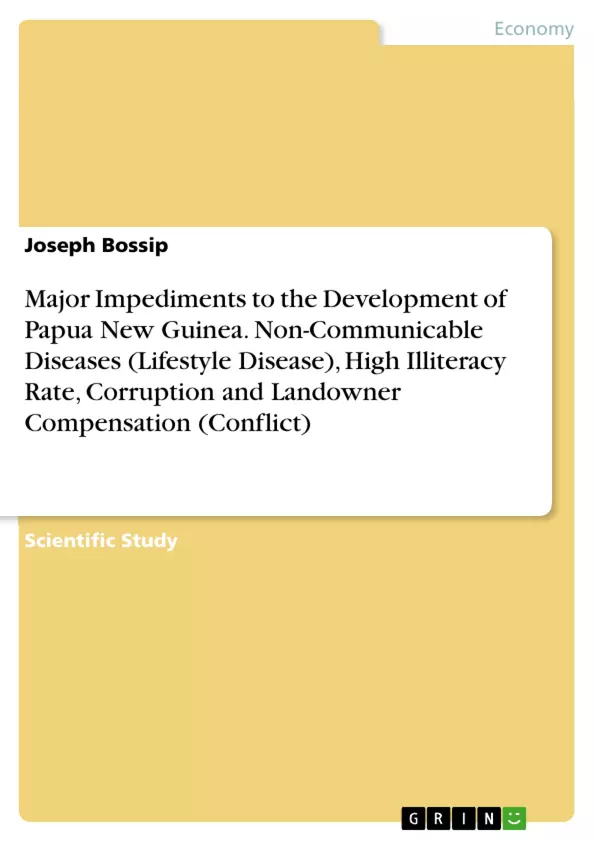This paper discusses some of the major impediments that are affecting the development of this country, Papua New Guinea and off course the general picture of the world. These impediments are identified as Lifestyle or Non Communicable Diseases, Corruption, High Illiteracy rate and Landowner issues especially land conflict and land compensation for mining.
I see the following as major impediments to the development of this nation; however people have different views, but I see these things are becoming barriers to the development of this nation.
Due to modernisation and westernisation, a lot of people in Papua New Guinea have already adopted western lifestyle. Thus, Non- Communicable Disease is prevalent in PNG. Non- Communicable Diseases are normally found in developed countries but now it is found in PNG. The first case was reported in 1971 but now it’s rose up to almost 46% of the total death rates in PNG is NCD. The survey shows that it is affecting most working class people who have direct correlation in term of input in the development of PNG through human resource development and economic development.
Secondly, corruption can also be regarded as one of the impediments to development in PNG because a lot of public funds have been misused at the political and bureaucratic level. We will explore the details in the discourse of this paper.
Thirdly, high illiteracy rate is another contributing factor hindering the progress of development in Papua New Guinea.
Finally, but not the least is land owner conflict and land compensations, it is also seen as an obstacle to the development of this nation of Papua New Guinea. Especially customary land acquisitions and landownership conflicts in mining areas. For example, Bougainville Copper Limited (BCL) has been closed down due to landowner compensations, as a result government infrastructures have been destroyed and lives have been claimed.
This paper also provides some strategies and recommendations to address the following issues highlighted above. Especially recommending the government of the day to look into these issues through policy development and legislative framework.
Further research is encouraged for the decision makers or policy makers to have sufficient information available to make informed decisions to address those issues before it’s too late.
Inhaltsverzeichnis (Table of Contents)
- Abstract
- Acronyms and Abbreviation
- Introduction
- Non Communicable Diseases (NCD)
- Corruption
- High Illiteracy Rate
- Landowners Conflict and Compensation
- Strategies and Recommendations
- Conclusion
- References
Zielsetzung und Themenschwerpunkte (Objectives and Key Themes)
This paper aims to analyze the major impediments hindering the development of Papua New Guinea, highlighting their impact on the country's progress. The paper delves into the causes and consequences of these impediments, exploring their influence on various aspects of PNG's social, economic, and political landscape.
- The impact of lifestyle diseases (Non-Communicable Diseases) on PNG's development.
- The role of corruption in undermining development efforts and public trust.
- The challenges posed by high illiteracy rates and their implications for human capital development.
- The complexities of landownership conflicts and compensation issues, particularly in mining areas.
- The need for effective strategies and recommendations to address these impediments and promote sustainable development.
Zusammenfassung der Kapitel (Chapter Summaries)
- Introduction: This chapter sets the stage for the paper, introducing Papua New Guinea and its developmental challenges. It emphasizes the importance of understanding these impediments for achieving sustainable progress.
- Non Communicable Diseases (NCD): This chapter examines the prevalence and impact of lifestyle diseases on PNG's development. It explores the factors contributing to the rise of NCDs and their implications for human resource development and economic growth.
- Corruption: This chapter analyzes the pervasiveness of corruption in PNG and its detrimental effects on development. It discusses the different forms of corruption, its impact on public funds, and its implications for good governance and transparency.
- High Illiteracy Rate: This chapter examines the challenges posed by high illiteracy rates in PNG. It explores the causes of low literacy levels and their impact on human capital development, economic productivity, and social progress.
- Landowners Conflict and Compensation: This chapter focuses on the complexities of landownership conflicts and compensation issues in PNG, particularly in mining areas. It examines the historical context of these conflicts, their impact on development projects, and the need for sustainable solutions.
- Strategies and Recommendations: This chapter presents a range of strategies and recommendations for addressing the impediments discussed in previous chapters. It emphasizes the need for government intervention, policy development, and community engagement to foster sustainable development.
Schlüsselwörter (Keywords)
The paper focuses on key themes such as non-communicable diseases, corruption, illiteracy, landownership conflicts, and development challenges in Papua New Guinea. It explores the impact of these factors on the country's progress and identifies strategies for addressing them.
- Quote paper
- Joseph Bossip (Author), 2015, Major Impediments to the Development of Papua New Guinea. Non-Communicable Diseases (Lifestyle Disease), High Illiteracy Rate, Corruption and Landowner Compensation (Conflict), Munich, GRIN Verlag, https://www.grin.com/document/302808



